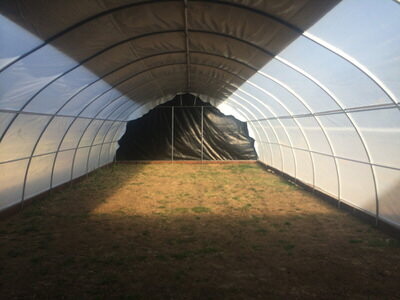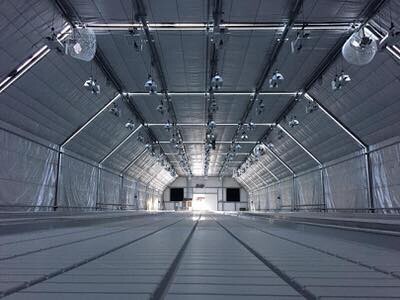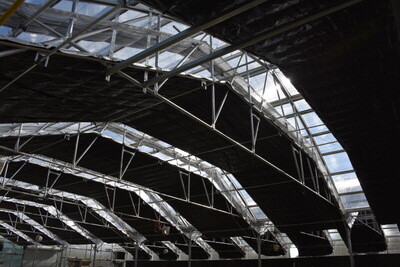What Is A Light Deprivation Greenhouse?
A light deprivation house is a kind of greenhouse that has been specially designed for full control over lighting factors. Manual or fully automated light deprivation greenhouses are used to spur growth and flowering cycles, allowing blooms and harvests several times per year. With the help of a blackout greenhouse, growers can perfectly control factors affecting plant growth, including light, temperature, and humidity, to shorten plant growth cycles and maximize yield.
A complete greenhouse system with the proper size systems for your climate and crop can help you pinpoint the perfect environment for hearty, sturdy plants. Correctly-sized heating and cooling systems, ventilation and air flow fans, and the right supplemental lighting is important to plant health and disease resistance. These components will the grower exacting control, enabling you to reach the most suitable microclimate for your plants.
We offer fully-automated light deprivation systems, as well as blackout tarps and hoop houses that can be operated manually. Our automated systems enable you to adjust and pre-program the amount of light, the frequency of light and dark exposure, and the environmental factors that your plants will rely on to bloom. For larger commercial operations, automated systems save time and can drastically reduce labor costs.
We offer both single span and multi span greenhouse systems. A single span is often the foundation for a multi span series, offering a greenhouse solution that is flexible and can grow as your operation expands. Although it covers a small area, a single span black-out greenhouse has all the functions needed for a smaller-scale, starting grower.
How Does A Blackout System Work?
Light deprivation methods control how much, and how often plants receive light. A blackout system uses material to cover the plants, simulating different seasonal changes. The resulting darkness tricks plants into responding, therefore growing or flowering on command.
During vegetative growth states, plants are bombarded with light that allows them to grow at rapid rates. Some plants grow up to two inches per day during the summer months and, in response to shortened periods of light, only flower in the fall when the daylight hours are shorter.
This is where the absence of light comes into play. A blackout system allows growers to stimulate plant responses as they choose, increasing plants to many hours of uninterrupted darkness every day, as they choose.
Once you start a light deprivation cycle, most plants will begin to react with hormone accumulation in a few days, due to the absence of red evening light. After a few weeks, this triggers flowering and blooming, rapidly producing a higher yield. This process can be repeated multiple times throughout a year, greatly extending your growing season.
What are my Grow Light Needs?
Supplemental grow lighting is also a major part of producing a profitable yield. Correct lighting is important for plant health and for inducing specific growth responses. Without proper spectrum and intensity, your crops are less likely to thrive. The type of lighting which works best for your plants, your available space, and the growth responses you are stimulating is key to creating an optimum growing environment.
Compact Florescent (CFL) and T5 Florescent lights are amongst the best lights for clones, seedlings and young plants. Bigger lights must be kept far away from young plants to avoid burning them, which ends up wasting a lot of light and energy, but by using smaller lights like fluorescents while plants are still short, you can save quite a bit of money on electricity during those first few weeks compared to using a high-powered grow light.
High Pressure Sodium (HPS) lights are the most effective High Intensity Discharge (HID) lights available. These lights emit high levels of light compared to other systems and have high yellow, orange and red spectrums to promote flowering.
Light Emitting Diode (LED) lights emit nearly double the lumens per watt over fluorescent or HID lights while using less energy and putting off less heat, and can be customized to put out as specific wavelength of light. LED grow lights are popular among growers as an alternative to HPS lights. LEDs have great penetration, so they don’t need to be moved frequently like fluorescents.
Light Emitting Plasma (LEP) lights emit full spectrum light and are known for their long life, while using almost 50% less energy than HPS lamps, resulting in lower operational costs.
What about Hydroponic Growing?
Hydroponic growing has long been an important technique in production. From the early basic days of hand-watering pots of inert medium with nutrients, to the newer, sophisticated systems of automated pumps, timers, and reservoirs, the aim is the same: to provide your plants with the fuel they need to flourish.
The disadvantages of growing exclusively in soil are:
- You may not be able to recycle your soil
- Soil is susceptible to pest problems
- It can be difficult to determine proper amount of nutrients
- And you need to carefully monitor soil pH
- Therefore, your soil quality significantly influences the final product
With Hydroponic growing, you use small amounts of grow media that can often be reused, while also precisely controlling what nutrients the plants are receiving and proper pH levels. With such levels of control, growers find that their buds are bigger and healthier.
Hydroponic greenhouses contain systems such as NFT channels or ebb and flow benching to give larger-scaled growers even more environmental control over their crop. Adding proper ventilation and lighting control to a hydroponic greenhouse increases yield and plant viability to take growers to the next level with ease.
Fully-Automated Greenhouse Systems
Today’s agricultural industry is big business, and to feed our future, we must explore technological innovations which push the boundaries of conventional cultivation.
Automation is rapidly becoming a mainstay in greenhouse production. Many medium to large-sized commercial operations already rely on some level of automation to manage aspects of their growing practices.
Simple partially motorized systems can operate only light deprivation shades, while more advanced controllers may also manage irrigation and climate systems. There are even harvesting systems available to take production even further away from a solely labor-powered endeavor.
A fully- automated production greenhouse utilizes computer-driven controls which eliminate the need for constant human monitoring of most vital greenhouse systems. Irrigation, lighting, CO2, temperature, humidity, soil pH, and nutrient needs can be monitored and programmed easily. Automated hydroponic systems can add ebb and flow benches to a schedule, take computerized root health and climate analysis readings, and suggest nutrient plans to further take manual management out of the cultivation process.
Our automated designs give the grower real-time control over the crop. Routine climate adjustments are automatically managed through algorithms and comprehensive sensory systems which collect zone-by-zone data analysis. Systems can have multiple stages to manage budding, flowering, cloning, growth, and rest cycles, depending on what response you are nurturing in your plants at the time. Let our greenhouse experts assist in designing the perfect level of automation for your growing needs.
What Greenhouse Structures Are Available?
We offer many different structures to accommodate many types of grower. Both complete greenhouse packages that take the guesswork out of setting up your system and custom designed greenhouses are available, including:
- Enclosed glass or polycarbonate greenhouses
- Open-air design greenhouses with rigid coverings
- Cold Frames and High Tunnels
- Single freestanding or multi-span, gable-connected greenhouses
What Other Systems Do We Offer?
Our greenhouse structures integrate the most up-to-date, modern agricultural technology available to create a systematic and efficient growing approach. Many of our structures offer inclusion of these modern elements:
- Odor Misting
- Odor Control Vent Panels
- CO2 Generators
- Nutrient injectors
- Heating/Cooling
- Shade Systems
- Environmental Controls
- Dehumidification
- Irrigation/Fertilization
- Insect Screens
- Benching Systems
- Radiant Heating
- Hybrid Grow Techniques
- Nutrients and Supplements



